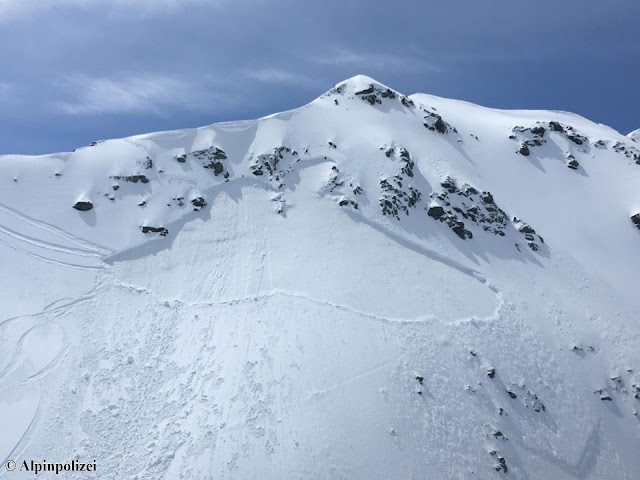Avalanches involving persons
Since last Sunday (3 May), four avalanches have been registered in which persons were involved. Initial analyses show that recently generated upper-level weak layers combined with snowdrifts deposited on top of them were the main cause of these releases. The weak layers formed due to danger pattern 4 (cold on warm) and danger pattern 9 (graupel). This occurred in very steep terrain on north-facing slopes above 2800 m. A brief description of the avalanches follows.
 |
| The uppermost flag indicates a recently released naturally triggered slab avalanche below the Rietz Grieskogel (more to follow). The other arrows mark the four avalanches referred to above in which persons were involved: from north to south, Zwieselbacher Rosskogel, western Seeblaskogel, Lüsener Spitze, eastern Daunkogel (all in Stubai Alps). |
Avalanche Zwieselbacher Rosskogel
 |
| Red circles: two fresh slab avalanches. 3 yellow markings: persons in the descent. Zwieselbacher Rosskogel, 2850 m, north. (photo: 03.05.2020) |
 |
| The snow profile was made by our observer Lukas Ruetz at the upper slab avalanche. The relevant weak layer was graupel, including faceted crystals above a melt-freeze crust. |
Avalanche Lüsener Spitze
 |
| Above the fracture, entry track is visible, beneath that, exit track. Lüsener Spitze, 3100 m, northeast. (photo: 03.05.2020) |
Avalanche eastern Daunkogel
On 3 May, 5 winter sports enthusiasts were below the northern gully leading up to the eastern Daunkogel. During the ascent a slab avalanche triggered, from which 4 of the group were able to escape. One person was partly buried in snow. All persons remained without injuries. The avalanche released at about 3250 m on an extremely steep north-facing slope. The length of the avalanche was about 700 m, width 250 m, fracture depth generally 30-50 cm.
 |
| Photo taken prior to the avalanche when 5 persons were in the ascent towards the eastern Daunkogel (red circles). (photo: 03.05.2020) |
 |
| Photo taken just after the avalanche. (photo: 03.05.2020) |
 |
| Aerial photo of avalanche on eastern Daunkogel taken by Alpine Police. (photo: 03.05.2020) |
 |
| Photo taken at orographically left avalanche fracture. The red arrow indicates the weak layer relevant to release: faceted crystals beneath a thin melt-freeze crust. (photo: 04.05.2020) |
 |
| Snow profile detailed view. Red arrow points to weak layer. Avalanche fracture was 35 cm deep at this point. |
Cause of avalanches
The cause of the avalanche releases lies in the weak layers which formed just prior to the occurrences and were the immediate result of variable weather conditions.
 |
| Data from relatively high-altitude station on Pitztal Glacier help to pinpoint cause: variable April weather. Ongoing temperature fluctuation, repeated bouts of snowfall, strong winds (esp. from 1 May, enhancing formation of slab above weak layers). Decisive for the avalanches was the snowpack moistening on 27-28 April, subsequently it cooled due to snowfall. Great temperature variations reinforced metamorphism (danger pattern 4: cold on warm). |
 |
| As comparison: Breiter Grieskogel station. The gray line in the second graph depicts the snowpack surface temperature, initially at zero degrees (thus, moist) then repeated leaps as temperatures tended lower, with fresh snow deposits on top. |
 |
| Recent precipitation in Tirol |
 |
| Typical mixture: sunshine, clouds, precipitation |
Precipitation often stemmed from convective clouds, i.e. similar to thunderstorms with powerful, vertical air currents. In such conditions, graupel often forms (in summertime, hail). If graupel is amply deposited it can form a weak layer when snow covers it.
 |
| Graupel on the surface in Defereggental (photo: 03.05.2020) |
Below, comparative shots of the northern aspect of Rietzer Grieskogel, taken from Inn Valley, also showing that weak layers causing these slab avalanches were relatively recent.
 |
| Photo from 23 April when, amid dry air masses, not a single slab avalanche but several loose-snow avalanches were observed. Also where the red circle is. |
 |
| Photo from 3 May: near the encircled zone of the photo above, a superficial slab triggered below a cornice. |
UPSHOT
Near-to-surface weak layers can currently be triggered by winter sports enthusiasts above about 2800 m on very steep north-facing slopes. In other aspects, we assume that increased solar radiation has already dispersed potential weak layers, that they are relevant only in high alpine terrain (around 3500 m). We unfortunately have no assured data from that altitude/terrain. Future developments of weak layers depend on weather conditions. If temperatures rise significantly, the weak layers could be destroyed quite rapidly; on the other hand, faceted snow crystals could persist for awhile.
Other news:
According to latest registered amounts of fresh snow (5 May), numerous loose-snow avalanches can be expected tomorrow on 6 May.
 |
| Loose-snow avalanches in extremely steep terrain (photo: 03.05.2020) |
 |
| Caution: cornices! (photo: 03.05.2020) |
 |
| Marmottes awakening from hibernation (photo: 03.05.2020) |
 |
| The slopes are rapidly becoming bare of snow. (photo: 03.05.2020) |
The next update of this blog will be published as soon as there is a significant change in the snow/avalanche situation in Tirol’s mountains.





































